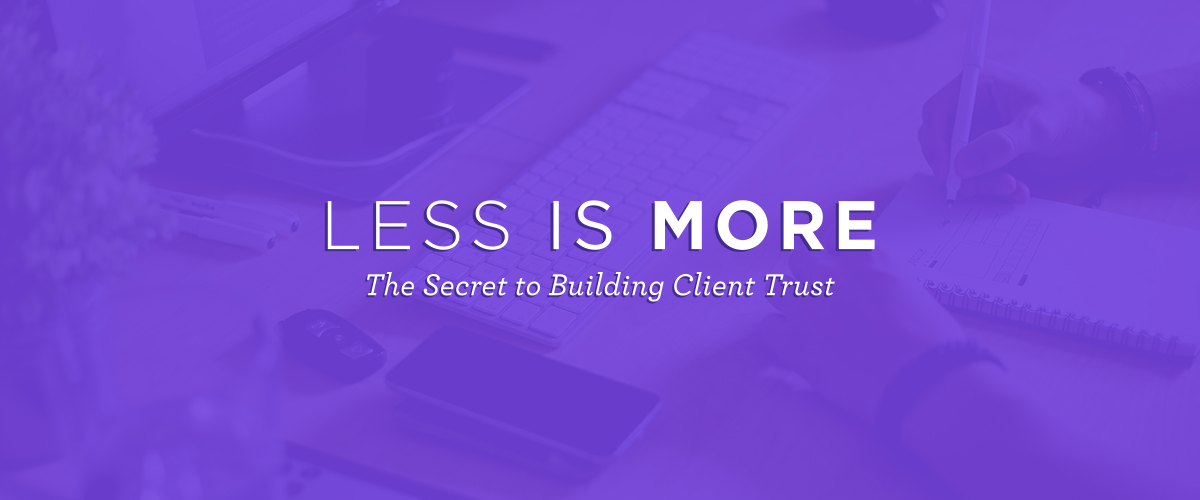
Less is More, The Secret to Building Client Trust
Thursday December 17th, 2015It takes work to maintain successful agency/client relationships. Here’s one thing designers can do to help build client trust.
Congratulations, designers! Your agency’s business development team has worked countless hours to win an awesome new project that you’re all excited to get started on. Now what?
If you create the most innovative design solution, the client will fall in love with your agency, right? I would respectfully disagree. More important than creating the perfect design is creating and fostering a good client relationship and building trust.
While this may seem obvious to anyone in a client facing position, it’s not always the first thing on a designer’s mind, and it is no easy feat. Just like relationships in our personal lives, it takes work to maintain successful agency/client partnerships. One wrong move during a presentation or interaction could rub the client the wrong way and put serious strain on the relationship.
Just like relationships in our personal lives, it takes work to maintain agency/client partnerships.
There are plenty of tips and tricks you can use when presenting design work to clients. One that has proven to be very successful at Brolik is putting a limit on the number of ideas we pitch.
Now some of you may think that sounds like crazy talk. The more choices we have the better, right?
Wrong.
Having more options is commonly seen as a positive thing, but research shows that’s just not the case. When agencies pitch too many ideas during design presentations, clients are more likely to become overwhelmed by the options. The human mind can only process so much information before running out of steam.
It’s also possible for clients to experience what some call the “paradox of choice.” Generally, people think that having more choices is better than having less. However, in decision making, when the number of choices goes up, the level of satisfaction goes down along with the confidence in the decision.
Neither of these scenarios leads to a happy client.
Often designers feel they need to present numerous options to appease their clients. They may think showing fewer options looks lazy, like they didn’t spend enough time on the project. But that’s not the case.
Adding extra options to increase perceived effort is a bad idea. To the client, “filler ideas” are seen as equally viable options, and including weak concepts to make the strong concepts stand out can totally backfire.
Our team had a similar experience in the past with a branding project. At the first design presentation, we weren’t completely sure what direction we wanted to take the brand, so we showed all of our ideas, the good and the bad.
It was a mistake!
From that point on, the client relationship started to suffer. We showed them so many ideas, they didn’t even know where to start. What’s more, because we bombarded them with so many choices, we began to lose credibility. We were the design experts, but we were having a hard time establishing a direction. We weren’t guiding them at all.
When overwhelmed with choice, people tend to be more irrational than rational. Our client feared making the wrong decision and almost cancelled the project altogether to avoid making a decision at all. But what did happen?
While this was in no way an ideal situation, it did teach us some important lessons about how to present design ideas to clients.
During our next branding project, we showed a maximum of five options at every design presentation. Not because we only had five ideas. We had dozens. But these five ideas were the most thought-out, thorough examples that we, the design professionals, thought would best represent the brand.
With fewer ideas presented, our client could spend the appropriate amount of time weighing their options, consequently making a better decision for their company. When faced with too many options, clients start evaluating things in terms of missed opportunities and their level of satisfaction declines. In this case, the limited options led to a very satisfied client who trusted our judgement enough to sign up for more work. Winning!
It’s important to consider all of your client needs when working on a project. They’re paying you to help their company succeed, and the last thing you want to do is ignore their requests. That being said, you’re the expert. You know what’s good and what’s bad, and it’s a waste of everyone’s time to present ideas that would reflect poorly on their business.
Guide them through the process using only your best work, and you will surely gain their trust and maybe even win more business. Good luck!